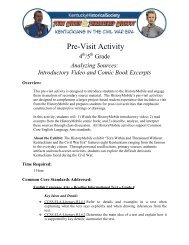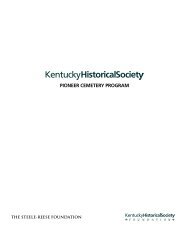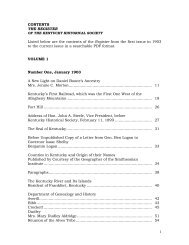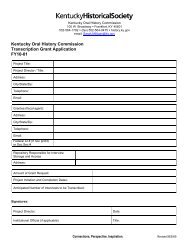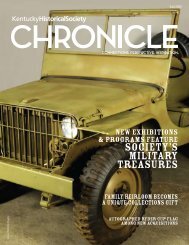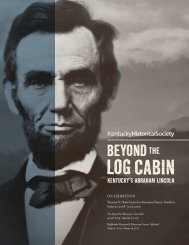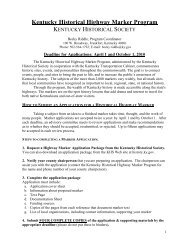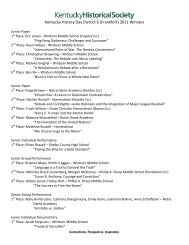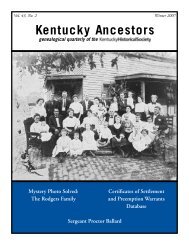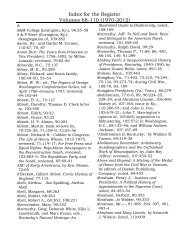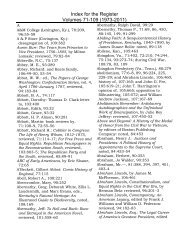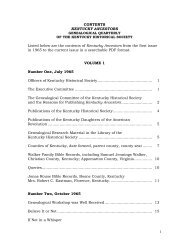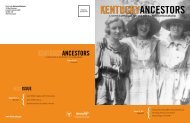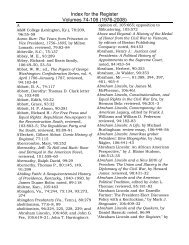Kentucky Ancestors, Volume 46, Number 3 - Kentucky Historical ...
Kentucky Ancestors, Volume 46, Number 3 - Kentucky Historical ...
Kentucky Ancestors, Volume 46, Number 3 - Kentucky Historical ...
Create successful ePaper yourself
Turn your PDF publications into a flip-book with our unique Google optimized e-Paper software.
microfilm publication M904). Consisting of<br />
fragmentary records from the Accountant’s Office<br />
of the War Department relating to the pay and<br />
supply of state militia in federal service—most of<br />
which survived a devastating fire at the department<br />
on 8 November 1800, while other military records<br />
of the post-Revolutionary period were destroyed—<br />
the manuscripts include correspondence; abstracts,<br />
warrants, receipts, and vouchers for claims for services<br />
rendered or provisions furnished; unit returns and<br />
supply lists; and expenditure accounts. Some of the<br />
records were also assembled from other government<br />
agencies by Secretary of War William Belknap in the<br />
later nineteenth century. 16<br />
Most of the <strong>Kentucky</strong> records pertain to Maj.<br />
Gen. Scott’s <strong>Kentucky</strong> Mounted Volunteers during<br />
the Northwest Indian War. In addition to ration<br />
and payroll receipts, there are reports that enumerate<br />
monthly provisions issued during the 1794 campaign.<br />
The itemized disbursements include such commissary<br />
goods as flour, beef, salt, soap, candles, vinegar, and<br />
whiskey. One report of provisions issued at Fort St.<br />
Clair noted the delivery of 708 rations, including<br />
seventy-six pounds of flour, twenty-two pounds of<br />
beef, and 4 gills of salt. 17 Other returns documented<br />
military and camp equipage such as penknives, paper,<br />
quills, ink stands and powder, orderly books, tents,<br />
pack mules and saddles, camp kettles, and bushels of<br />
corn. The files also contain some correspondence and<br />
directives from Anthony Wayne to Scott regarding<br />
appointments of general and field officers to the<br />
<strong>Kentucky</strong> Mounted Volunteers and accounts of spies<br />
who received bounties for taking Native prisoners. 18<br />
Two documents for Geiger’s Company, Well’s<br />
Corps of Mounted Riflemen, have also been<br />
reproduced in Muster Rolls and Payrolls of Militia<br />
and Regular Army Organizations in the Battle of<br />
Tippecanoe, November 1811 (National Archives<br />
microfilm publication T1085). The records include<br />
a field and staff payroll receipt showing $124.12<br />
remitted to Maj. Samuel Wells and Adjutant<br />
James Hunter, as well as a company payroll and<br />
roster. Of particular interest, annotations in the<br />
remarks column of the payroll identify the casualties<br />
sustained at Tippecanoe, which consisted of three<br />
officers (including Geiger) and ten privates slightly<br />
132 | <strong>Kentucky</strong> <strong>Ancestors</strong><br />
or badly wounded, together with four men killed in<br />
action: Corporal Stephen Mars and Privates James<br />
Summerville, Joseph Smith, John Owsley, and Joseph<br />
Maxwell. Another soldier, Abraham Walk, fell sick<br />
before the battle and was left behind at Fort Harrison<br />
(a supply station established en route to the battle). 19<br />
<strong>Kentucky</strong> militia played a prominent role in the<br />
military history of the United States. As a result of<br />
the predominantly volunteer nature of the early U.S.<br />
military establishment, state and local militias—<br />
including volunteers from <strong>Kentucky</strong>—provided a<br />
great portion of military service during periods of<br />
conflict on the untamed frontiers following the end<br />
of the Revolutionary War. From the late eighteenth<br />
to the early nineteenth centuries, ongoing disputes<br />
with Native Americans over hegemony in the trans-<br />
Appalachia region necessarily drew in <strong>Kentucky</strong><br />
militiamen to patrol the wilderness and protect<br />
scattered settlements. Participating in the operations<br />
of the Regular Army during the Northwest Indian<br />
War (1790–95) and the Wabash expedition (1811),<br />
including the pivotal battles of Fallen Timbers<br />
and Tippecanoe, <strong>Kentucky</strong> militia served with<br />
distinction in major campaigns to solidify the status<br />
of the United States as a sovereign nation. These<br />
activities generated a host of useful federal records<br />
that document the military experiences of individual<br />
Kentuckians who served their state and fledgling<br />
nation during a tumultuous but formative time in<br />
history.<br />
List of <strong>Kentucky</strong> Militia, 1790–1811<br />
Compiled military service records are available at the<br />
National Archives.<br />
The units are listed according to their arrangement in<br />
NARA holdings.<br />
Battalions marked (*) served with Anthony Wayne at<br />
the battle of Fallen Timbers.



